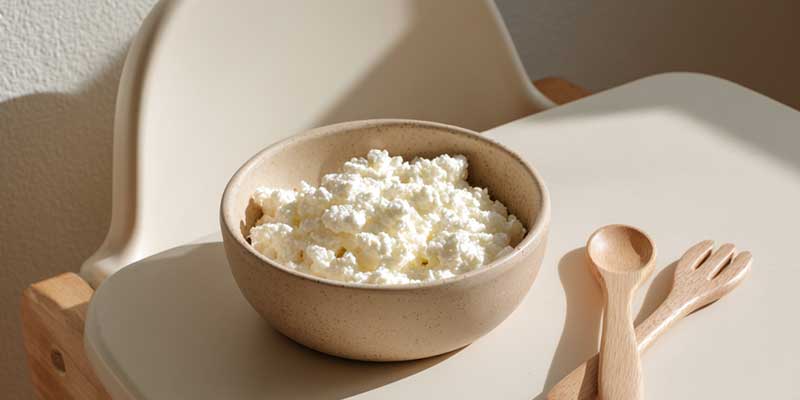
COTTAGE CHEESE FOR TODDLERS: SAFE, HEALTHY, AND PICKY EATER APPROVED
When introducing your little one to the exciting milestone of solid food, finding options that are both nutritious and enjoyable can be a challenge — that’s where cottage cheese for toddlers comes in. It’s a simple, wholesome choice that makes mealtime easier.
Pair cottage cheese with fruit, vegetables, or mix it into recipes for a sneaky nutrition boost.
Raising toddlers can be challenging but mealtimes don’t have to be! We hope this is a useful guide to healthy toddler snacks and meals that take one thing off your plate and help you heap nutrition onto theirs!
Little kids need big nutrition

The first 1,000 days — from conception through a child’s second birthday — are a time of rapid growth, and toddlers have big nutritional needs packed into very small appetites. Dairy is a great solution that makes nutrient-dense goodness accessible to sometimes finicky eaters. That’s why dairy foods like cottage cheese are essential during the first 1,000 days of life and a no-brainer for toddler nutrition.
Cottage cheese is a simple, nutritious food for early childhood development — and beyond — packed with essential nutrients that support brain, bone, and a strong immune system.
It’s nutrient-dense, offering protein to build muscle, calcium and phosphorus for strong bones, and B vitamins for energy and brain development — all in portions toddlers can realistically finish. Cottage cheese delivers high-quality protein for toddlers, keeping them satisfied between meals and reducing the seemingly endless requests for snacks (or is that just wishful thinking?)
Cottage cheese also has a soft, scoopable texture that makes it easy for self-feeding and gentle on developing digestive systems, while its mild flavor encourages acceptance of new foods, perfect for picky eaters!
What to know about feeding toddlers cottage cheese

Cottage cheese is versatile enough to meet your toddler where they are — whether they’re still mastering self-feeding or already digging in on their own. Below are a few easy, age-appropriate ways to serve it.
How to serve cottage cheese for babies 6–12 months
- Remember, breast milk, infant formula, or both, should be a child’s primary source of nutrition until at least six months of age or when developmentally ready for solid food. Check with your pediatrician if you have questions about when to introduce solids
- If ready to start solids: Offer small spoonfuls as a single-ingredient taste test
- If ready to start solids: Choose full-fat, plain cottage cheese for the extra calories little ones need for growth and brain development
How to serve cottage cheese for toddlers 12–18 months
- Sneak it into simple recipes like these three-ingredient cottage cheese pancakes or this creamy pasta sauce
- Serve small dollops as a finger food they can scoop with their hands or try with a spoon
- Mix into scrambled eggs, mashed sweet potatoes, or oatmeal for added protein
- Pair with soft fruit (pears, peaches, or berries) to balance flavor and texture
How to serve cottage cheese for toddlers 18–24 months
- Offer as a snack with crackers, soft veggies, or toast strips for dipping
- Mac and cheese is a trusted toddler staple. Next time they ask, amp up the protein with this cottage cheese mac and cheese. It’s ready in 20 minutes and boasts 13 grams of protein in a serving. Does it get any better than that?
- This cottage cheese alfredo isn’t just a great source of protein for toddlers, it can also be a delicious weeknight meal for the whole family to enjoy
- Let them in on the fun! Toddlers love to help. Let them add their own fruit or sprinkle of cinnamon on top. It’s more exciting to eat something you made yourself
Sometimes the simplest foods — served in familiar, flexible ways — are the ones toddlers accept most easily. Cottage cheese is a great example of a high-protein food for toddlers, helping support growth, muscle and brain development, and healthy eating habits as they explore new flavors and textures.
Common questions about cottage cheese for toddlers

You might not think of cottage cheese as a go-to snack for your toddler, so it’s natural to have questions. We answered some of the most common ones, so you can feed with confidence.
Is cottage cheese a choking hazard for babies?
No need to worry — cottage cheese is generally considered a low choking risk. Of course, any food can pose a challenge if little ones are still learning to chew and swallow. It’s even common for babies and toddlers to gag while getting used to solid food. But it’s very different than choking!
The key is to serve cottage cheese in an age-appropriate way, whether that’s offering small spoonfuls or letting them scoop it up with their hands. Just be prepared for a mess! As with all meals, staying within arm’s reach gives you peace of mind while your child gains confidence at the table.
Is cottage cheese a common allergen?
Since cottage cheese is made from cow’s milk, it can trigger allergic reactions in some children. Cow’s milk is a common childhood food allergen, though many kids outgrow it by early school age.
If your child has a known or suspected milk allergy, talk with your pediatrician or allergist before introducing cottage cheese. If the risk is low, start small, serve it on its own, and watch for any reaction.
The good news? Many children tolerate dairy just fine, and with guidance from a medical professional, most will outgrow a milk allergy over time.
My little one turned their nose up at cottage cheese. What now?
It’s completely normal if your toddler seems unimpressed with cottage cheese the first time — or even the first few times.
Toddlers are learning to explore new textures and flavors at their own pace, and refusal is part of the process.
The key is gentle persistence: Keep offering small amounts alongside familiar foods, without pressure. Over time, repeated exposure helps little ones build comfort and curiosity, and what they once ignored may soon become a favorite.
Try, try again: Simple ways to reintroduce cottage cheese for toddlers
- Stir cottage cheese in mashed berries or applesauce for a familiar, fruity twist
- Offer cottage cheese as a dip for soft fruit sticks, graham crackers, or mini pancakes
- Spread a thin layer of cottage cheese on toast, and then add a sprinkle of cinnamon or a drizzle of nut butter
Remember: No pressure, just playful exposure. Every little taste (or even just a smear on the face!) counts. With so many ways to serve it, parents can feel good knowing that cottage cheese is not only versatile but also one of the most straightforward, affordable choices they can make.
High quality dairy equals high quality nutrition

It almost seems too good to be true that something as simple as cottage cheese can become a nutritious go-to. Whether you’ve got a picky eater or a sous chef-in-training, cottage cheese is an affordable, accessible source of nutrient-rich dairy that can simplify everything from snack time prep to ensuring a healthy, growing toddler.
It takes a lot of energy to be a toddler, and arguably even more to chase one around! That’s why cottage cheese isn’t just a healthy toddler snack. It’s packed with high-quality protein and a convenient way to keep the whole family nourished and asking for seconds.
At Dairy Farmers of America (DFA), we’re a cooperative of family farmer-owners committed to providing high-quality dairy. From the first 1,000 days to every day that follows, our farmer-owners and our family of farmer-owned brands strive to make nutrition easy and accessible.
Find a DFA farmer-owned brand near you to get the best dairy has to offer, and support family dairy farmers at the same time.